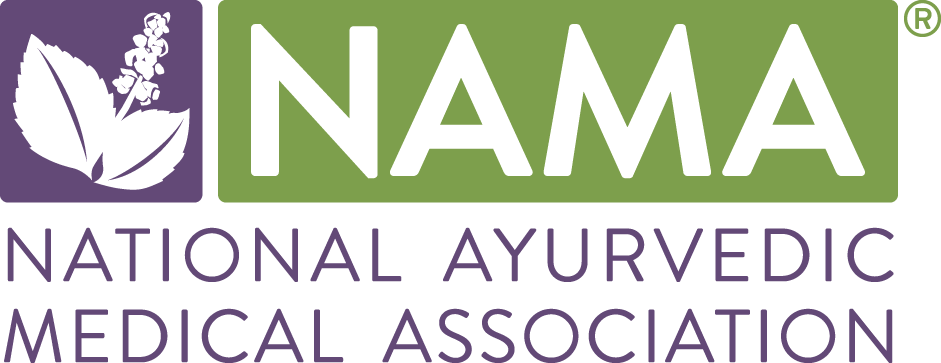THE IMPORTANCE OF SANSKRIT IN PRACTICING AYURVEDA IN THE U.S.
by Maria Radloff
Like yoga, Ayurveda exists within the language of the gods—Sanskrit. Rooted in poetic Sanskrit verses, Ayurveda had been passed down solely through the memorization of these sacred scriptures until only recently when Ayurveda began its journey beyond the borders of India.
Unlike yoga, whose language and culture have been completely Americanized in this country, Ayurveda has maintained more of its traditional Indian character. It is almost impossible to study Ayurveda in the U.S. without using some Sanskrit terminology. Everyone understands vāta, pitta, and kapha, even if they’re not pronounced properly.
The meaning of so many Ayurvedic concepts is so deeply embedded in the language, that it would be nearly impossible to teach Ayurveda without using Sanskrit. Imagine replacing the word pañcakārma with “cleansing process” every time you refer to this Ayurvedic procedure. The English term hardly does justice to the treatment’s complexities. Likewise, how would you refer to the process of upaśaya without having that word in your Sanskrit vocabulary? Sanskrit words don’t always translate neatly into English because they often convey concepts whose meanings are deeper and more nuanced than their literal definitions suggest. Some of these Sanskrit concepts don't exist in Western culture, so translating them is impossible; you have to explain them instead, which can be arduous. Without the Sanskrit terms, you have to resort to lengthy explanations or deficient English replacements to speak about Ayurvedic principles and practices.
One of the beautiful things about Ayurvedic terminology is that once you understand the root words, you can decipher and understand many of the Ayurvedic terms more clearly by breaking them into their original parts. For example, it’s easy to figure out that hrdroga refers to heart disease once you know that hrd means “heart” and roga means “disease.” This approach gets a little trickier with words like grdhrasi (the Ayurvedic term for sciatica). In this case, the root grdhra, which means vulture, refers to a characteristic sign of the condition—an ungainly vulture-like walk.
As someone who learned Sanskrit in the U.S. through yoga, I had an advantage in understanding the language of Ayurveda through these root words. For example, prasara, which means “spread,” is used in Ayurveda to refer to the third stage of disease, when it spreads from its original site to other locations in the body. This word is familiar to yogis from the frequently mispronounced name of the popular pose prasārita pādottānāsana, or wide spread intense extended leg posture. Because yoga and Ayurveda were born from the same philosophy, Sanskrit is equally interwoven into both sciences, so understanding one will help a student understand the other.
One of the biggest obstacles to learning Sanskrit is the variety of ways that words are spelled. There is the Americanized version of Sanskrit that spells words phonetically, such as moola, dosha, and sheeta. This is helpful for those unfamiliar with the Sanskrit alphabet, but creates a quandary for those with a little bit of Sanskrit knowledge, since some of the sounds are lost or unclear.
Then there is the IAST convention of writing that uses special markings on characters. This system indicates exactly how each sound should be pronounced, but is altogether confusing to anyone without Sanskrit training, not to mention scary!
And the final obstacle is that Sanskrit is downright hard! In the Sanskrit classes I take, everyone, including the teacher, is always looking up terms, and we frequently have to correct our study guides and handouts. I always tell my own Sanskrit students that they just need to let go of trying to “get it”—that Sanskrit can't be “gotten” in the usual way. I explain that I will make mistakes, and they will make mistakes and that's just how it goes. Sometimes the hardest part is just being okay with that.
If you’re studying Ayurveda in the U.S., I believe you’ll find that most schools use at least some Sanskrit vocabulary, even if it’s just the most basic, Americanized form. Here are several key reasons why I believe it is important for anyone studying Ayurveda (and yoga) to learn Sanskrit, along with the sounds of its alphabet.
Reason 1: Lineage
Ayurveda always has been, and still is, handed down via Sanskrit ślokas and sūtras. As an Ayurvedic student, I’ve found that almost every class I attend is taught by a traditional Ayurvedic Doctor from India who was required to learn not only Sanskrit, but also the classic Ayurvedic texts. Not a class goes by where we don’t hear a verse from Aṣṭānga Hrdayam or Caraka Samhitā. My teachers sometimes need to recall a memorized verse from a Sanskrit text to answer a question correctly.
Reason 2: Communication
For Ayurvedic professionals to understand one another, they must share a common language. I have met people from many different countries and cultures who practice Ayurveda, and regardless of their native language, they all share the common language of Ayurveda. While I don't think it's important to know Sanskrit when communicating with rogis, as most of them won't apprehend the nomenclature, it is important when working or learning around other Ayurvedic professionals, researching topics in this field, or reading Ayurvedic texts. Without knowing Sanskrit, one will be locked out of understanding many books and other resources.
Reason 3: Understanding
The principles of Ayurveda remain the same whether they’re conveyed in English or Sanskrit, but when you learn them in English, your understanding of them will only be as deep as the translator’s. There is deeper wisdom held in the language of Ayurveda, as many of the Sanskrit words don't translate into English. This is due to the fact that the concepts the words are expressing don’t exist in the American culture. To understand the philosophies underlying Ayurveda, we must connect with the words that embody these unfamiliar ideas. Ayurveda has been learned through chanting and sound for millennia, so the true meaning of Ayurveda resides in its native language.
Reason 4: Purify the Mind
One of the most efficient ways to purifymanas is to use Sanskrit and chanting. Spoken out loud or even internally in the mind, Sanskrit can purify the mind and create a more sattvic state. To use Vedic chants or mantras for these types of practices, knowledge of the Sanskrit alphabet and the sounds associated with it is vital.
Reason 5: Sound
In Sanskrit, the meaning of a word is considered inseparable from its sound, so when words are mispronounced, their meaning is lost. For example, if you say ananda with only one measure of sound on the first a, you’re actually saying “no bliss.” To tap into bliss, you need to pronounce aananda (ānanda) with two beats on that first a sound. For example, I always explain to my yoga teacher-training students that there are no wrong pose names, just new poses; for example, mispronouncing nāvāsana as navāsana turns boat pose into number nine pose. So to properly use Sanskrit as a healing tool, you must understand the sounds of Sanskrit.
Reason 6: Accuracy
If you’re going to work with Sanskrit words, why not do it right? There is no extra effort involved in saying ka-pha than there is in saying ka-ffa (i.e.,a breathy “p” sound versus an “f” sound). For someone new to Ayurveda, it is just as easy to learn the correct pronunciation of a word as it is to learn an incorrect one. Therefore, I think it is exponentially more important for a teacher of Ayurveda to know how to pronounce Sanskrit words than it is for the student. The students will echo the teacher’s pronunciation. To learn Sanskrit properly they need an authentic learning experience, where the teacher is well versed in speaking the Sanskrit sounds. One of the things I appreciate most about my teachers is their precise pronunciation. Even though there are words they Americanize for students, I hear all of the authentic Sanskrit sounds that make up the words when they speak—the retroflexes, the aspirates, the nasal sounds. Hearing these sounds is so helpful. Since I understand the nuances of the Sanskrit alphabet, I can usually grasp the meaning of words more fully when the sounds of the Sanskrit characters that the words are rendered in are spoken exactly as the phonetic rules of the language dictate. So why not incorporate proper Sanskrit pronunciation into Ayurvedic education? The price of the education will remain the same, but it will provide far greater benefits.
Reason 7: Standardization
As Latin is to the Western medical industry, so is Sanskrit to Ayurveda. Most industries have their own languages. As a web designer, I need to be able to speak in HTML and CSS, which are computer languages. Architects, engineers, lawyers all speak a unique language that conveys the principles and concepts that inform their day-to-day work. Why should our industry be any different? Sanskrit is the precise way to communicate the meaning of Ayurvedic terms. Imagine trying to explain Ayurvedic concepts or use your own everyday language rather than standard-industry terms when discussing a case. The lack of a common language would significantly increase the potential for errors and miscommunications that could undermine the effectiveness of traditional Ayurvedic protocols.
Reason 8: Truth
Without knowing the language of Ayurveda, there will always be a barrier between the truth and you. Sanskrit embeds universal truths within it, and since Ayurveda and yoga constantly invoke the Self and the discovery of those truths, it can serve as a conduit to that magical ah-ha moment in your journey. Sanskrit is not an old, abandoned language; it is the living language of the Divine that lives deeply within us all, that unites us, and provides language for the deepest wisdom we could ever touch upon.
In Conclusion
Although I love that Ayurveda continues to spread (prasara) around the world, adapting to an endless number of languages and cultures, I will always believe that there is just a bit more truth and understanding conveyed when the Sanskrit language is used. The principles of Ayurveda are powerful whether described in English, Spanish, or Hindi, but the true master of Ayurveda that will use this divine language and really know Ayurveda in its deepest sense.
About the Author
Maria Radloff is an Ayurvedic Wellness Practitioner student at Kerala Academy. She begrudgingly began studying Sanskrit and Vedic chant when she became an ashtanga student of Dave and Cheryl Oliver in Scottsdale, Arizona. Her studies quickly unlocked the magic of Sanskrit, and soon she was devoting more energy to the language than to the asanas—in effect, the language became her yoga. Maria teaches Sanskrit for yogis and Ayurveda students and professionals.
Editor Note: I used “American” Sanskrit in a normal font, such as Ayurveda and Yoga. Words that are meant to be in pure Sanskrit are in italics with IAST.





















